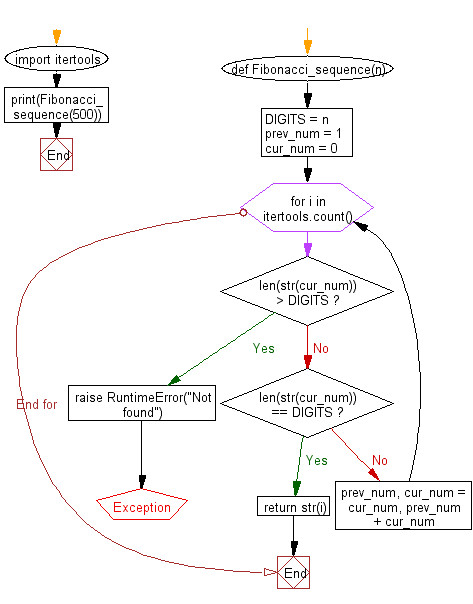Python Challenges: Find the index of the first term in the Fibonacci sequence to contain 500 digits
Python Challenges - 1: Exercise-49 with Solution
Write a Python program to find the index of the first term in the Fibonacci sequence to contain 500 digits.
In mathematics, the Fibonacci numbers, commonly denoted Fn form a sequence, called the Fibonacci sequence, such that each number is the sum of the two preceding ones, starting from 0 and 1
The Fibonacci sequence is defined by the recurrence relation:
Fn = Fn−1 + Fn−2, where F1 = 1 and F2 = 1.
Hence the first 12 terms will be:
F1 = 1
F2 = 1
F3 = 2
F4 = 3
F5 = 5
F6 = 8
F7 = 13
F8 = 21
F9 = 34
F10 = 55
F11 = 89
F12 = 144
The 12th term, F12, is the first term to contain three digits.
Sample Solution:
Python Code:
import itertools
def Fibonacci_sequence(n):
DIGITS = n
prev_num = 1
cur_num = 0
for i in itertools.count():
# At this point, prev = fibonacci(i - 1) and cur = fibonacci(i)
if len(str(cur_num)) > DIGITS:
raise RuntimeError("Not found")
elif len(str(cur_num)) == DIGITS:
return str(i)
prev_num, cur_num = cur_num, prev_num + cur_num
print(Fibonacci_sequence(500))
Sample Output:
2390
Flowchart:

Python Code Editor:
Contribute your code and comments through Disqus.
Previous: Write a Python program to find the millionth lexicographic permutation of the digits 0, 1, 2, 3, 4, 5, 6, 7, 8 and 9.
Next: Write a Python program that takes a string and encode it that the amount of symbols would be represented by integer and the symbol.
What is the difficulty level of this exercise?
Test your Programming skills with w3resource's quiz.
Python: Tips of the Day
Find current directory and file's directory:
To get the full path to the directory a Python file is contained in, write this in that file:
import os dir_path = os.path.dirname(os.path.realpath(__file__))
(Note that the incantation above won't work if you've already used os.chdir() to change your current working directory, since the value of the __file__ constant is relative to the current working directory and is not changed by an os.chdir() call.)
To get the current working directory use
import os cwd = os.getcwd()
Documentation references for the modules, constants and functions used above:
- The os and os.path modules.
- The __file__ constant
- os.path.realpath(path) (returns "the canonical path of the specified filename, eliminating any symbolic links encountered in the path")
- os.path.dirname(path) (returns "the directory name of pathname path")
- os.getcwd() (returns "a string representing the current working directory")
- os.chdir(path) ("change the current working directory to path")
Ref: https://bit.ly/3fy0R6m
- New Content published on w3resource:
- HTML-CSS Practical: Exercises, Practice, Solution
- Java Regular Expression: Exercises, Practice, Solution
- Scala Programming Exercises, Practice, Solution
- Python Itertools exercises
- Python Numpy exercises
- Python GeoPy Package exercises
- Python Pandas exercises
- Python nltk exercises
- Python BeautifulSoup exercises
- Form Template
- Composer - PHP Package Manager
- PHPUnit - PHP Testing
- Laravel - PHP Framework
- Angular - JavaScript Framework
- Vue - JavaScript Framework
- Jest - JavaScript Testing Framework
